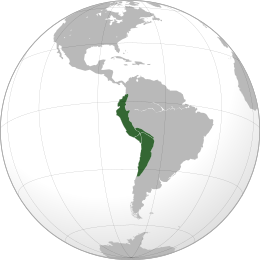Realm of the Four Parts (1438–1533): Difference between revisions
From ProleWiki, the proletarian encyclopedia
More languages
More actions
No edit summary Tag: Reverted |
(Undo revision 78938 by 2A00:F41:700A:753D:8C6B:4E9F:A9D5:EF18 (talk): please ideally specifc a direct reference from Mariategui's own words (writing or speeches) rather than the Jacobin, thank you!) Tag: Undo |
||
| Line 1: | Line 1: | ||
{{Infobox country|name=Realm of the Four Parts|native_name=Tawantinsuyu|image_flag=Suntur Paucar.svg|capital=Cusco|government_type=Absolute monarchy|life_span=1438–1533|flag_type=Royal emblem|image_map=Tawantinsuyu map.svg|map_width=260|map_caption=The empire at its peak in 1525|official_languages=Quechua|area_km2=2,000,000}} | {{Infobox country|name=Realm of the Four Parts|native_name=Tawantinsuyu|image_flag=Suntur Paucar.svg|capital=Cusco|government_type=Absolute monarchy|life_span=1438–1533|flag_type=Royal emblem|image_map=Tawantinsuyu map.svg|map_width=260|map_caption=The empire at its peak in 1525|official_languages=Quechua|area_km2=2,000,000}} | ||
The '''Inca Empire''', officially the '''Realm of the Four Parts''', was a precolonial state in [[South America]]. It relied on a large professional army and an administrative bureaucracy. Despite only having Stone Age [[means of production]], it was able to construct a 40,000-km road system and large monuments such as Machu Picchu.<ref name=":0222" /> It integrated its agricultural system on a national scale and retained communal elements that enabled a good standard of living for its population.<ref name=":0">{{Web citation|author=Sergio Rodriguez Gelfenstein|newspaper=[[Workers World]]|title=How long will Peru last? History weighs on today’s events|date=2020-12-18|url=https://www.workers.org/2020/12/53314/|archive-url=https://web.archive.org/web/20230606095617/https://www.workers.org/2020/12/53314/|archive-date=2023-06-06 | The '''Inca Empire''', officially the '''Realm of the Four Parts''', was a precolonial state in [[South America]]. It relied on a large professional army and an administrative bureaucracy. Despite only having Stone Age [[means of production]], it was able to construct a 40,000-km road system and large monuments such as Machu Picchu.<ref name=":0222" /> It integrated its agricultural system on a national scale and retained communal elements that enabled a good standard of living for its population.<ref name=":0">{{Web citation|author=Sergio Rodriguez Gelfenstein|newspaper=[[Workers World]]|title=How long will Peru last? History weighs on today’s events|date=2020-12-18|url=https://www.workers.org/2020/12/53314/|archive-url=https://web.archive.org/web/20230606095617/https://www.workers.org/2020/12/53314/|archive-date=2023-06-06}}</ref> | ||
Inca rule was very unpopular, and the empire easily fell to [[Monarchy of Spain (1516–1700)|Spanish]] invaders in the 16th century.<ref name=":0222">{{Citation|author=Neil Faulkner|year=2013|title=A Marxist History of the World: From Neanderthals to Neoliberals|chapter=The Medieval World|page=72–73|pdf=https://cloudflare-ipfs.com/ipfs/bafykbzacedljwr5izotdclz23o3c5p4di4t3ero3ncbfytip55slhiz4otuls?filename=Neil%20Faulkner%20-%20A%20Marxist%20History%20of%20the%20World_%20From%20Neanderthals%20to%20Neoliberals-Pluto%20Press%20%282013%29.pdf|publisher=Pluto Press|isbn=9781849648639|lg=https://libgen.rs/book/index.php?md5=91CA6C708BFE15444FE27899217FBA8E}}</ref> The Spanish soon proved to be much more brutal than the Inca rulers and created a [[Feudalism|feudal system]] under a [[Colonialism|colonial]] viceroy.<ref name=":0" /> | Inca rule was very unpopular, and the empire easily fell to [[Monarchy of Spain (1516–1700)|Spanish]] invaders in the 16th century.<ref name=":0222">{{Citation|author=Neil Faulkner|year=2013|title=A Marxist History of the World: From Neanderthals to Neoliberals|chapter=The Medieval World|page=72–73|pdf=https://cloudflare-ipfs.com/ipfs/bafykbzacedljwr5izotdclz23o3c5p4di4t3ero3ncbfytip55slhiz4otuls?filename=Neil%20Faulkner%20-%20A%20Marxist%20History%20of%20the%20World_%20From%20Neanderthals%20to%20Neoliberals-Pluto%20Press%20%282013%29.pdf|publisher=Pluto Press|isbn=9781849648639|lg=https://libgen.rs/book/index.php?md5=91CA6C708BFE15444FE27899217FBA8E}}</ref> The Spanish soon proved to be much more brutal than the Inca rulers and created a [[Feudalism|feudal system]] under a [[Colonialism|colonial]] viceroy.<ref name=":0" /> | ||
Latest revision as of 11:19, 6 December 2024
| Realm of the Four Parts Tawantinsuyu | |
|---|---|
| 1438–1533 | |
|
Royal emblem | |
 The empire at its peak in 1525 | |
| Capital | Cusco |
| Official languages | Quechua |
| Government | Absolute monarchy |
| Area | |
• Total | 2,000,000 km² |
The Inca Empire, officially the Realm of the Four Parts, was a precolonial state in South America. It relied on a large professional army and an administrative bureaucracy. Despite only having Stone Age means of production, it was able to construct a 40,000-km road system and large monuments such as Machu Picchu.[1] It integrated its agricultural system on a national scale and retained communal elements that enabled a good standard of living for its population.[2]
Inca rule was very unpopular, and the empire easily fell to Spanish invaders in the 16th century.[1] The Spanish soon proved to be much more brutal than the Inca rulers and created a feudal system under a colonial viceroy.[2]
References[edit | edit source]
- ↑ 1.0 1.1 Neil Faulkner (2013). A Marxist History of the World: From Neanderthals to Neoliberals: 'The Medieval World' (pp. 72–73). [PDF] Pluto Press. ISBN 9781849648639 [LG]
- ↑ 2.0 2.1 Sergio Rodriguez Gelfenstein (2020-12-18). "How long will Peru last? History weighs on today’s events" Workers World. Archived from the original on 2023-06-06.

